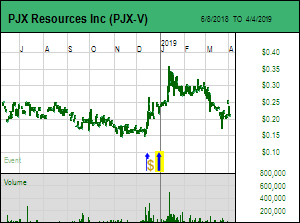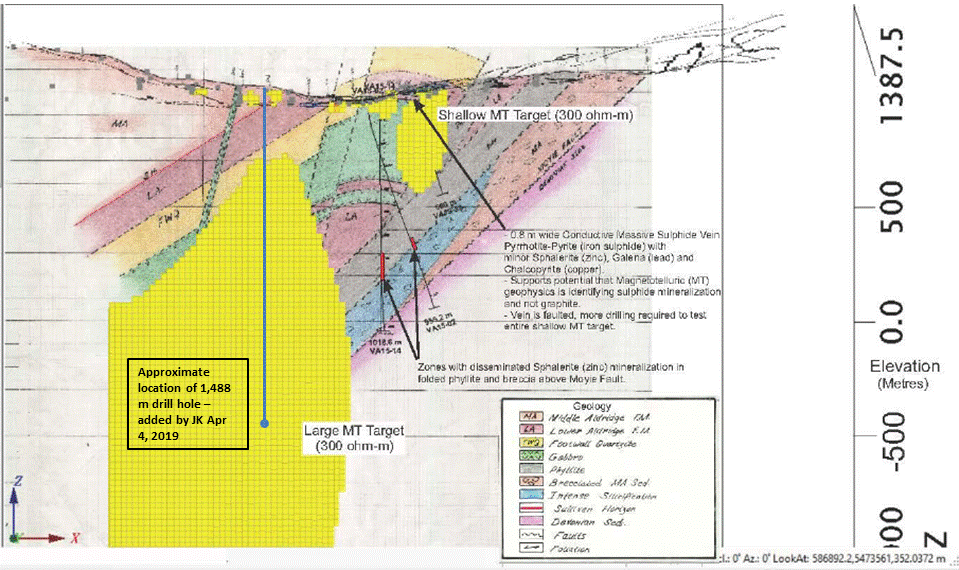| |
Tracker - April 4, 2019: Deep PJX hole needs downhole survey to pinpoint Broken Hill style prize
 PJX Resources Inc announced on April 2, 2019 that it has completed a deep hole on the 100% owned Vine project in southeastern British Columbia. PJX drilled a vertical hole to a depth of 1,488 m testing a magneto-telluric anomaly interpreted as a massive sulphide body with a strike potential of 800 m and down-dip extent of 2,000 m. Unlike an earlier angled hole which was abandoned due to deviation, this hole underwent little deviation and was stopped within the "attenuation zone" to avoid entering the Moyie Fault zone, a northwest dipping, northeast-southwest trending regional fault, and possibly getting stuck. PJX was keen not to lose steel in this hole because its purpose in addition to getting lucky was to facilitate a downhole geophysical survey and serve as a pilot hole for additional wedge holes testing off-hole conductors. PJX did not get lucky in hitting the prize, but it did not get unlucky in the sense of a wasted hole. PJX Resources Inc announced on April 2, 2019 that it has completed a deep hole on the 100% owned Vine project in southeastern British Columbia. PJX drilled a vertical hole to a depth of 1,488 m testing a magneto-telluric anomaly interpreted as a massive sulphide body with a strike potential of 800 m and down-dip extent of 2,000 m. Unlike an earlier angled hole which was abandoned due to deviation, this hole underwent little deviation and was stopped within the "attenuation zone" to avoid entering the Moyie Fault zone, a northwest dipping, northeast-southwest trending regional fault, and possibly getting stuck. PJX was keen not to lose steel in this hole because its purpose in addition to getting lucky was to facilitate a downhole geophysical survey and serve as a pilot hole for additional wedge holes testing off-hole conductors. PJX did not get lucky in hitting the prize, but it did not get unlucky in the sense of a wasted hole.

The geology to the north of the Moyie Fault is prospective for Sedex-style deposits such as Sullivan while the rocks to the south are younger sediments where the Sullivan time horizon is far too deep to represent an exploration target. Nothing, neither sulphides nor graphite, to explain the MT anomaly (conductivity) was encountered, nor anything with sufficient density to explain the East gravity anomaly. The "attenuation zone" is a deformation zone of phyllite (an super metamorphosed version of slate) within the hanging wall of the Moyie Fault. A couple shallower, angled holes drilled in 2015 to test the East gravity target intersected low grade banded sphalerite updip from the 2019 hole which intersected the phyllites at a depth of 900 m. The news release, which talks mainly about the initial hole that tested a much smaller shallow MT target, makes no sense to readers not steeped in Sullivan geo-talk, and the stock price should have collapsed. But it did not and I needed to talk with CEO John Keating to understand why.

According to Keating the deep hole is not a bust because for the first time ever tourmalinization has been observed on the Vine property. The 2019 hole encountered metamorphosed phyllite and blocks of unmetamorphosed sediments beneath 900 m within the "attenuation zone", both of which contained tourmaline. According to Sullivan expert Dave Pighin tourmalization occurs within and around the Sullivan deposit. It is a late stage alteration product formed after the iron, zinc and lead sulphides of a smoker system have been exhaled into a marine environment to form a pancake shaped Sedex deposit like Sullivan around the feeder event. Its presence above the interpreted deep target on the adjacent Monroe project of Highway 50 Gold Corp is what has the Leask brothers convinced they are one deep drill hole away from making a Sullivan Two discovery underneath Monroe Lake. But while the Leasks believe Monroe hosts a relatively intact Sedex deposit similar to the 156 million tonne Sullivan deposit, albeit with a smaller size, Keating remains convinced that the prize represented by the MT anomaly on the adjacent Vine project is a Broken Hill style system. In other words, Vine hosts a former Sedex deposit whose massive sulphides have been rolled and squeezed by folding and other metamorphic pressures so that the resulting body or bodies no longer fit into any depositional model. He does not, however, rule out that what he hopes to find on the Vine property was once part of whatever is left under Monroe Lake. In his view the pressure from the Moyie Fault may have dragged away part of a giant Sedex deposit, rolling and squeezing the massive sulphides into a series of sub vertical lenses. There is also the ugly scenario that mother nature did not leave anything behind under Monroe Lake, just peripheral evidence of a departed monster. Highway 50 will have to figure out how to fund and drill a hole that successfully tests their target.

The reason PJX devotes so many words to describing the 0.2 m (true width) massive sulphide vein intersected by the hole which tested the shallow MT target is that the mineralization is very similar to that of the Vine vein about 1,000 m to the southwest on which most of the historic work focused. It even managed to grade 1.97% zinc, 3.73% lead and 23.37 g/t silver. The narrow massive sulphide vein cuts through a fracture within a pre-existing vein of bull quartz and has a texture called "durchbewegung", a German word that literally means "moving through". It has not been hydrothermally emplaced; metamorphic pressure remobilized the sulphides from some other source and squeezed them into the current location. The interval does not fully explain the shallow MT anomaly; Keating believes that there are multiple such squirts at this level which collectively generate the MT anomaly. Both the Vine vein and the shallow MT vein point to a deeper source readily explained by the large MT anomaly.

PJX did a weak job providing a verbal description in its press release, and it did not provide any graphics to explain the location of the large MT hole and what it encountered.I have added my best guess to the old-fashioned pencil crayon section I found in a PJX presentation to help me make sense of this story. A downhole geophysical probe will be lowered into this hole to survey conductivity in all directions at every depth. The data collection and interpretation will not be complete until early May, at which point, if the location(s) of massive sulphide bodies have been pinpointed in 3D, PJX will update the market with proper graphics as a prelude to resumption of wedge drilling in late May. The key assumption is that wherever it is that the conductive massive iron sulphides are located, the zinc and lead sulphides (sphalerite and galena), which are neither conductive nor magnetic, are also present. But if the model explaining the Vine and Shallow MT veins is correct, it really is just all about figuring out the location of the massive sulphide bodies from which their mineralization emanated. PJX Resources Inc remains a KRO Favorite with a Bottom-Fish Spec Value rating. My hopes for a major discovery remain pinned to the Deep MT target on the Vine property, but I will want to see validation by mid May that the target remains plausible. Meanwhile management will need to start dressing up the Zinger-Eddy gold play as well as the newer sediment-hosted Parker copper play.
|